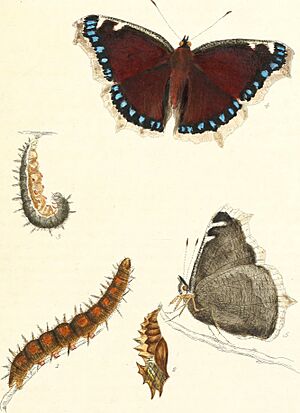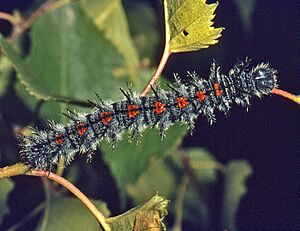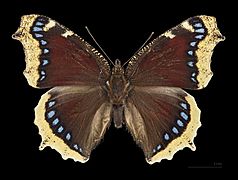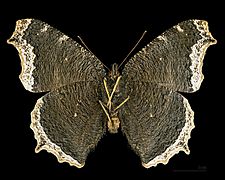Nymphalis antiopa facts for kids
Quick facts for kids Nymphalis antiopa |
|
|---|---|
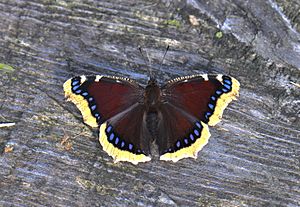 |
|
| Upperside | |
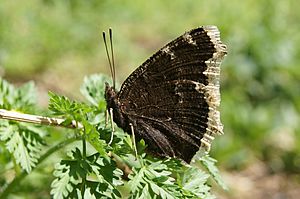 |
|
| Underside | |
| Conservation status | |
| Scientific classification |
The Nymphalis antiopa, also known as the mourning cloak butterfly in North America, is called the Camberwell beauty in Britain. This large butterfly lives naturally in Eurasia and North America.
Young mourning cloak butterflies are sometimes called spiny elm caterpillars. Other old names for this butterfly include "grand surprise" and "white petticoat." These butterflies are strong flyers. They are sometimes found far from where they usually live when they migrate.
Mourning cloak butterflies can live for 11 to 12 months. This is one of the longest lifespans for any butterfly! It is also the official state insect of Montana in the U.S.
Contents
What's in a Name?
Why "Mourning Cloak" in North America?
In many European countries, like Germany and Sweden, the name for this butterfly means "mourning cloak." This name likely came with settlers from these countries. The butterfly's dark wings with pale edges look like a dark cloak worn during a time of sadness or "mourning."
One author, L. Hugh Newman, said the butterfly's pattern looked like a girl who didn't want to wear a sad mourning dress. So, she let a bit of a bright dress show underneath.
Why "Camberwell Beauty" in Britain?
The name "Camberwell beauty" comes from when two of these butterflies were first found. This happened in August 1748 in a place called Camberwell in South London. An author named Moses Harris wrote about this discovery. He called the butterfly "grand surprise" or "Camberwell beauty."
Where Do Mourning Cloaks Live?
Mourning cloak butterflies live all over the northern half of the world. You can find them across North America and northern Eurasia. They are often seen in forests with hardwood trees. However, they can live in almost any habitat.
Sometimes, they are seen as far south as the northern parts of South America. But they are not common in warmer U.S. states like Florida. They are also sometimes found in temperate parts of Asia, even in Japan. These butterflies prefer cold, mountainous areas.
A few mourning cloaks fly to Great Britain each year in summer and autumn. But they usually do not stay there. Scientists think the mild, wet winters in Britain stop them from living there for long.
How Do Mourning Cloaks Look?
Mourning cloak butterflies change a lot as they grow. Each stage looks very different!
Eggs
When first laid, mourning cloak eggs are amber-yellow or light olive-green. As they grow, their color changes to lilac-pink. Then they get darker, almost black, before they hatch. The eggs are tiny, about 0.7 by 0.9 millimeters. Females lay them in rings around the stems of their food plants. Later, they might lay them on the top of leaves.
Larvae (Caterpillars)
The caterpillars are very noticeable. They have black bodies with a line of eight reddish-orange dots down their backs. These bright colors warn predators that they might not taste good. Their legs are dark red. Their bodies are covered with short hairs, black spines, and white dots. Full-grown caterpillars can be about two inches long.
Pupae
Mourning cloak pupae (the chrysalis stage) are usually tan or brown-gray. They are about 0.8 inches long, but can grow to over 1.1 inches. They have two rows of sharp, red-tipped spikes. The chrysalis also has a "beak" and two head horns.
Adult Butterflies
The adult mourning cloak butterfly is large and unique. Its markings are special and do not look like any other butterfly. This makes it easy to spot! Its wingspan can be up to four inches wide.
The top side of its wings is a dark maroon or brown. They have ragged, pale-yellow edges. Bright, shiny blue spots line the black area between the maroon and yellow parts. The underside of the wings is gray with stripes and the same pale-yellow edges.
These butterflies are part of the Nymphalidae family. They are called "brush-footed butterflies" because their front legs are hairy. Male and female mourning cloaks look very similar.
Reproduction and Life Cycle
Mating Behavior
Male mourning cloak butterflies often mate with several females. Males will try to attract females by defending a good spot. These spots might be sunny places near trees, parks, gardens, or lakes. A male will guard his chosen area for several days. This helps him find and mate with more female butterflies.
Their mating season starts in spring. Female mourning cloaks then find a host plant to lay their eggs. Adult butterflies are first seen from late spring to early summer. They then enter a "dormant" state during the summer, like a summer nap. This is called aestivation.
They also show diapause. This means they can pause their development if conditions are not right. Some butterflies start to migrate in September and October. They then spend the winter sleeping. Their mating cycle begins again in the spring, from April to June.
Life Cycle
Mourning cloaks, like all butterflies, go through complete metamorphosis. This means they change completely from one stage to the next:
- Egg
- Larva (caterpillar)
- Pupa (chrysalis)
- Adult butterfly
Before leaves grow in spring, mourning cloaks lay their eggs in rings around the twigs of host plants. These plants are very important because they provide food for the young caterpillars. Female butterflies can lay eggs up to two or three times a year.
The newly hatched caterpillars stay together. They shed their skin four times as they grow. Each time they shed their skin, it is called an instar. After the fifth skin shed, they are fully grown caterpillars.
Next, the caterpillar changes into a pupa. It forms a tan or gray chrysalis that hangs from plant stems. This pupa stage is a resting period for the butterfly to mature. This change takes about fifteen days. After this, an adult mourning cloak butterfly emerges from the chrysalis.
Behavior
Migration
Adult mourning cloak butterflies sleep during the winter months. They often hide in tree holes or under loose tree bark, sometimes covered by snow. They are often one of the first butterflies seen flying in the spring. Some studies have shown that they can migrate long distances. For example, some have flown from Germany to Greece.
Ecology
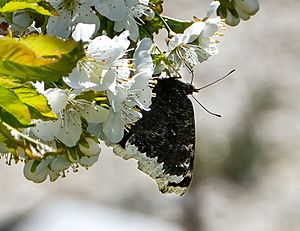
What Do They Eat?
When caterpillars hatch, they start eating the leaves of their host plants. They eat plants like willow (Salix nigra), American elm, hackberry, hawthorn, wild rose, birch species (Betula verrucosa), Alnus incana, and poplar. The caterpillars live together in silky nests on the host plant. They spread out just before they turn into pupae.
Adult mourning cloaks mostly drink tree sap, juice from ripe or fallen fruits, and sugary liquid from aphids. They rarely drink nectar from flowers.
Who Eats Them?
Mourning cloak butterflies face many predators as they grow. Their eggs can be eaten by beetles, ants, wasps, and mites. Adult butterflies can be eaten by praying mantises, dragonflies, birds, reptiles, and other animals.
How Do They Protect Themselves?
Adult mourning cloaks use camouflage to hide from predators. When they rest on trees, they fold their wings back. Their dark wings help them blend in with the tree bark.
Another way they protect themselves is by joining other butterflies. They might fly aggressively towards attackers, like birds. They can also make loud clicking sounds when they fly away from a predator.
To stay warm in cold places, mourning cloaks find sunny spots. Their dark wings help them soak up as much heat from the sun as possible.
Young caterpillars sometimes eat eggs that have not hatched yet. The caterpillars also stay in groups. This helps protect them from predators because there are many of them. Both caterpillars and pupae can twitch at the same time if they are disturbed. This might be a way to scare off predators.
Do They Pollinate?
Mourning cloak butterflies are not known to be major pollinators. This is because they mostly eat tree sap, not flower nectar. However, they can still help pollinate flowers sometimes.
Mourning Cloaks and People
Are They Pests?
Sometimes, groups of mourning cloak caterpillars can eat all the leaves off young trees. This can happen in nurseries, tree farms, and parks. This damage has been seen in places like Oregon and Canada. Young willow and poplar trees can lose all their leaves because of the caterpillars. However, older, larger trees are usually not affected.
Research About Them
Mourning cloak butterflies have been used in science experiments. Scientists wanted to see if the environment affects how butterflies look. They thought that very hot or cold temperatures during development could change their appearance. Experiments in the 1890s showed that temperature shocks changed the color of the pupae. Later, it was found that these color changes were due to hormones reacting to different temperatures.
Protecting Them
Mourning cloak butterflies are protected by law in Switzerland and Austria. In Finland, their numbers are generally increasing. They are also considered "safe" in the Czech Republic. These butterflies seem to like areas that have had fire breaks. This is probably because fire breaks create more open spaces and clearings, which are better habitats for them.
Types of Mourning Cloaks (Subspecies)
There are different types, or subspecies, of the mourning cloak butterfly:
- N. a. antiopa (Linnaeus, 1758)
- This is the main type, first found in Sweden.
- N. a. hyperborea (Seitz, 1913) (Canada, Alaska)
- This type lays more amber-yellow eggs. Their caterpillars have shorter, thicker spines than European mourning cloaks. The blue spots on their wings might be more violet.
- N. a. lintnerii (Fitch, 1857) (slightly larger; southeastern Canada, eastern U.S.)
- N. a. asopos (Fruhstorfer, 1909) (Japan)
See also
In Spanish: Nymphalis antiopa para niños



